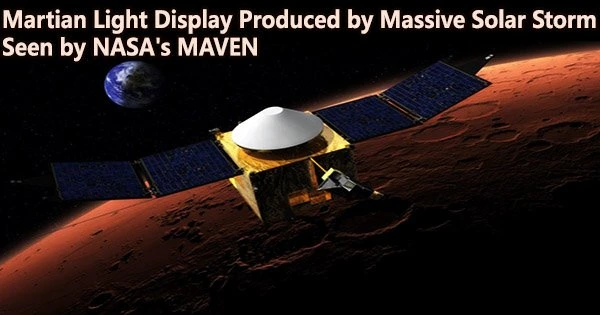Due to solar storms that started on August 27 (2022), NASA’s MAVEN spacecraft saw two distinct ultraviolet aurorae at the same time for the first time in its eight years of orbiting Mars.
The only instrument on Mars capable of simultaneously observing the Sun’s activity and the response of the tenuous Martian atmosphere is MAVEN, the Mars Atmosphere and Volatile Evolution mission. Real-time analysis and simulations of the solar eruptions from NASA’s Moon to Mars Space Weather Analysis Office also allowed the MAVEN team to correctly predict when the developing solar storm would reach the Red Planet.
Because Mars, unlike Earth, lacks a worldwide magnetic field to protect against the potentially harmful radiation solar storms can bring, accurate space weather forecasting is essential to helping protect both present missions and future human explorers to the Red Planet.
It started with the Sun
On Aug. 27, an active region on the Sun produced a series of solar flares, which are intense bursts of radiation. A coronal mass ejection (CME), a massive explosion of plasma and magnetic energy that leaves the Sun and travels across space, was observed in conjunction with the flare activity. This interplanetary CME impacted Mars a few days later.
This CME produced one of the brightest solar energetic particle (SEP) events that the MAVEN spacecraft has ever observed. The SEPs that were accelerated ahead of the CME were observed at Mars by MAVEN’s SEP detector on Aug. 27.
It’s exciting to still be observing ‘firsts’ like these simultaneous aurora so many years into the mission. We have so much to learn about the atmosphere and how solar storms affect the Red Planet. Our team cannot wait for the next few years of observing the most extreme conditions during the MAVEN mission’s lifetime.
Shannon Curry
In reality, a number of MAVEN’s equipment, including the Magnetometer, Solar Wind Ion Analyzer, and Solar Wind Electron Analyzer, were all able to measure the intensity of the solar storm.
“By utilizing space weather models of CME propagation, we determined when the structure would arrive and impact Mars,” said Christina Lee, a space physicist at the University of California, Berkeley, who is a member of the MAVEN mission team and is collaborating with the Moon to Mars Space Weather Analysis Office scientists. “This allowed the MAVEN team to anticipate some exciting disturbances in Mars’ atmosphere from the impacts of the interplanetary CME and the associated SEPs.”
Catching the Martian light show
Particles unleashed by the solar storm bombarded Mars’ atmosphere, causing bright auroras at ultraviolet wavelengths. MAVEN’s Imaging Ultraviolet Spectrograph (IUVS) instrument observed two types: diffuse aurora and proton aurora.
Timing played a role in why this amazing pair was seen together at the same time. The season of dust storms on Mars has come to an end, as it does every year when it comes closest to the Sun. As a result of these dust storms, water vapor is able to travel to high altitudes where it is split apart by sun UV light, releasing hydrogen atoms.
The dayside of the planet emits ultraviolet emissions when the incoming solar wind strikes all this extra hydrogen. These so-called “proton aurora” just so happened to occur at the same time as the entry of even more energetic particles, which further penetrated the atmosphere and produced diffuse aurora visible throughout the entire nightside.
Sumedha Gupta, a postdoctoral researcher with the IUVS team at the Laboratory for Atmospheric and Space Physics at the University of Colorado Boulder, first noticed the coincidence during her routine check of incoming data a few days after the event.
“I was so surprised to see proton aurora at the same time as diffuse aurora, because it had never happened before,” she said. “They’re both increasing with solar activity, so we hope it keeps happening!”
A sign of the storms to come
This light show is a sign of things to come for Mars and for the MAVEN team. As the Sun gets closer to its solar maximum in 2024–2025, it becomes more and more active, causing flares and CMEs. Solar maximum occurs when solar activity is at its highest point during the Sun’s 11-year solar cycle, therefore CMEs and SEPs are anticipated to become more frequent and continue to have an impact on Mars’ atmosphere.
“It’s exciting to still be observing ‘firsts’ like these simultaneous aurora so many years into the mission. We have so much to learn about the atmosphere and how solar storms affect the Red Planet,” said Shannon Curry, MAVEN’s principal investigator at the University of California, Berkeley. “Our team cannot wait for the next few years of observing the most extreme conditions during the MAVEN mission’s lifetime.”





